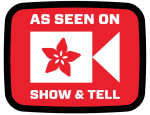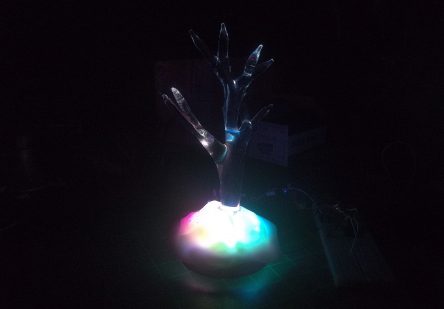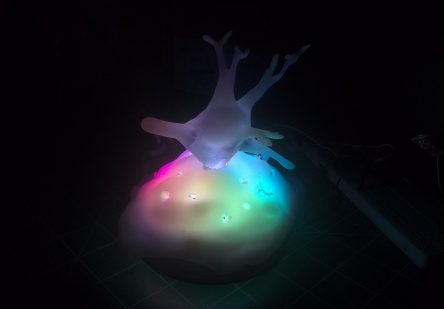Glassblowing + electronics collaboration: NeoPixels, clear forms and Instamorph
Recently I’ve been collaborating with glassblowing artist and student Kenny Galusha to explore dynamic lighting within his hand-blown glass work. Earlier we discovered that some glass pieces do amazing things when you hold a high-power RGB LED up to them, and we’ve been trying to learn how to exploit the effects ever since.
At first, our intuition was to experiment with different types and amounts of color and texture, which we will continue doing. Just for fun, though, we tried out a clear piece of glass and realized that the optical effects were much more interesting than we expected. Since then we’ve almost exclusively been working with clear forms and discovering lots of fun new effects!
 Around this time I decided to try replacing the cumbersome high-power RGB LEDs with more compact Adafruit NeoPixels. Working with high-power RGB LEDs will definitely be part of the plan in the future, but for now I needed a simpler way to experiment with lighting. Adafruit’s NeoPixels handle all of the electronic interfacing required to use the awesome WS2812 integrated RGB LEDs, which are tiny (but super-bright) LEDs that can be networked together to form long chains and interesting configurations.
Around this time I decided to try replacing the cumbersome high-power RGB LEDs with more compact Adafruit NeoPixels. Working with high-power RGB LEDs will definitely be part of the plan in the future, but for now I needed a simpler way to experiment with lighting. Adafruit’s NeoPixels handle all of the electronic interfacing required to use the awesome WS2812 integrated RGB LEDs, which are tiny (but super-bright) LEDs that can be networked together to form long chains and interesting configurations.
The ease of use for these little buggers is fantastic, and I’ll definitely be using them more and more in the future! For all of the experiments shown in this article I am using the 16 LED NeoPixel ring from Adafruit installed into a 3D-printed mount.
Working with Instamorph hand-moldable plastic
Once we had a prototype base with a NeoPixel ring installed we began experimenting with different kinds of diffusing material, mostly from around my apartment. I remembered that I still had a jar of Instamoprh hand-moldable plastic laying around, so we gave it a go. Not only is it a phenomenal material for light diffusion, but it can be easily molded into all sorts of interesting shapes.
 Instamorph ships in a jar of small pellets (about the size/shape of lentils), which you pour into a pot of warm water until they turn clear. Normally you pull the clear mass of pellets out and work it like clay until it is the shape you want, but I really liked how just pellets looked when they were all stuck together. We pulled it out, shaped it a little bit and dropped it into a bowl of cold water to cool it back down. I drilled a hole into the center, which grips the clear glass pieces that Kenny made perfectly. The result was pretty dang awesome (see the second video below).
Instamorph ships in a jar of small pellets (about the size/shape of lentils), which you pour into a pot of warm water until they turn clear. Normally you pull the clear mass of pellets out and work it like clay until it is the shape you want, but I really liked how just pellets looked when they were all stuck together. We pulled it out, shaped it a little bit and dropped it into a bowl of cold water to cool it back down. I drilled a hole into the center, which grips the clear glass pieces that Kenny made perfectly. The result was pretty dang awesome (see the second video below).
Next we flattened out the Instamorph and smoothed it out, then rolled it onto other glass pieces that Kenny had made with all sorts of cool textures. We realized that we could actually sample, distort and mix textures using this method, much like you might sample colors from paints. We are excited to keep experimenting with this cool material as both a structural element and a light diffuser!
Bonus: shown on Adafruit’s live “Show and Tell” Google+ Hangout!
 Every week Limor “ladyada” Fried and Phil Torrone from Adafruit host a live “show and tell” Google+ Hangout that anyone can join to talk about their projects, which is one of my favorite ways to share cool stuff I’m working on (albeit not as often as I’d like). I showed up last weekend and talked about some of this work, which is available for watching here (starting at about 7 minutes in):
Every week Limor “ladyada” Fried and Phil Torrone from Adafruit host a live “show and tell” Google+ Hangout that anyone can join to talk about their projects, which is one of my favorite ways to share cool stuff I’m working on (albeit not as often as I’d like). I showed up last weekend and talked about some of this work, which is available for watching here (starting at about 7 minutes in):
Bonus video: bag of rice!
While experimenting with different materials to use as light diffusers I had a hunch that simple rice might actually do a pretty good job. I put a little bit of basmati rice in a baggy and got this cool looking result!

